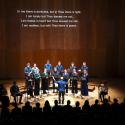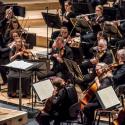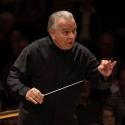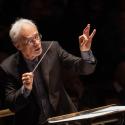If the bust of Sir Henry Wood that watches over the stage of the Royal Albert Hall had come to life, Commendatore-like, during last night’s concert, I can’t help feel that he would have been smiling. Beethoven nights – once a popular Proms fixture – have lately fallen off the calendar, but alongside various nods to tradition have this year returned. Following Jiří Bělohlávek and Paul Lewis’s recent concerto-fest, Paavo Järvi and the Deutsche Kammerphilharmonie Bremen last night presented a second all-Beethoven programme. Between the heart-racing tempos and exuberant playfulness, any suggestion of conservative nostalgia quickly became irrelevant.
The opening of Beethoven’s Symphony No 1 was however something of a false start – and not just the one the composer intended – for an orchestra that ended the evening with such style. Tuning issues in the upper woodwind smudged the opening bars, confusing the elegant clarity of Beethoven’s wrong-key joke. But by the time we were into the flirtatious exchanges of the second subject things had settled down, and the orchestra’s communicative energy began to make its case.
This most youthful of Beethoven’s symphonies is an irrepressible negotiation between lightly worn ambition and convention, and Järvi’s playful precision proved itself a natural fit. Wry smiles were never far away, their knowingness balanced by the enthusiasm of the swift speeds and extremity of articulation – dynamics throughout the evening were particularly dramatic at the lower end, culminating in all but inaudible passages in the second encore, in which only the movement of bows proclaimed the presence of sound.
For all its elegance and precision however, and even allowing for the difficult acoustics of the Albert Hall, this opening symphony lacked projection and aural punch, feeling “chamber” in a sense that the orchestral writing simply does not imply. This lack was only made more clear by the latter portion of the programme, which sacrificed some of the inward, in-joke musical conversations between the sections for a more audience-directed and public approach – one far better suited to a hall in which intimacy is so entirely alien.
For Beethoven’s Violin Concerto the orchestra were joined by Hilary Hahn, a violinist whose tone-quality is surely one of the sweetest and most distinctively ringing in the business. Set against the straight precision of the orchestra, Hahn’s pure delivery made a lot of sense. Understated to a fault, hers can be often the performance of a supermodel: coolly and transcendently beautiful, but untouchable. Here however, her delicately exploratory gestures were given the space to unbend a little, and the simplicity of the opening of the Larghetto had all the fragile charm of a young ballet dancer, its opening entry venturing onto the stage with graceful uncertainty.
Strongest in her lyrical upper-register, the earthy energy of the final movement was perhaps the greatest challenge for Hahn’s mighty technique. But if I didn’t quite believe the folk element of proceedings, this was more than made up for by the soaring purity of the G minor section with its song-like quality.
The rendition of Beethoven’s Symphony No 5 that followed the interval saw Fate knocking with altogether unseemly haste. Barely had Järvi set foot on the podium before we plunged forward, the still-chattering audience left scrambling to catch up with a dervish that had all the attack the evening’s opening symphony had lacked. Aided by additional orchestral forces, the sound finally achieved the solidity and depth necessary, and daring pianissimos were balanced out by the clattering attack of an absolutely unified string section.
Järvi’s elegant humour and sensitivity to detail were once again on display, yielding a gloriously stealthy bassoon solo in the third movement whose pizzicato string accompaniment was unsettling in its dramatically subdued delivery, before collapsing into a final Allegro, which had all the single-minded drive of a dance of death.
Solid without being staid, familiar without being hackneyed – this Beethoven night was a worthy heir to Wood’s traditions, and a persuasive case for their reinstatement. Risks were taken that didn’t always come off, but within the safe and appreciative embrace of an Albert Hall capacity crowd, that’s exactly as it should be.














Add comment